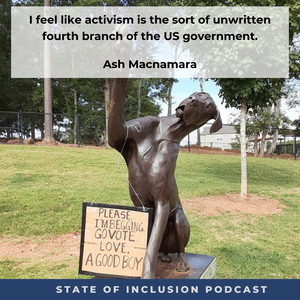Episode 66, 23 min listen
We believe in the transformative power of art. It's a potent tool that can be used to touch hearts and open minds and contribute to the creation of a more inclusive and equitable community. Over the years, we've talked with artists, but this conversation is different. It is about street art, or what I might call guerilla art. Work that lives at the intersection of art and activism. It's about a troupe of artists who engage in activism, support other activists, and use their art to, as they say, "surprise you out of your normal routine."
AUDIO PLAYER
You can access this episode wherever you listen to podcasts via our pod.link.
ADDITIONAL RESOURCES
Read more about Luther Blisset.
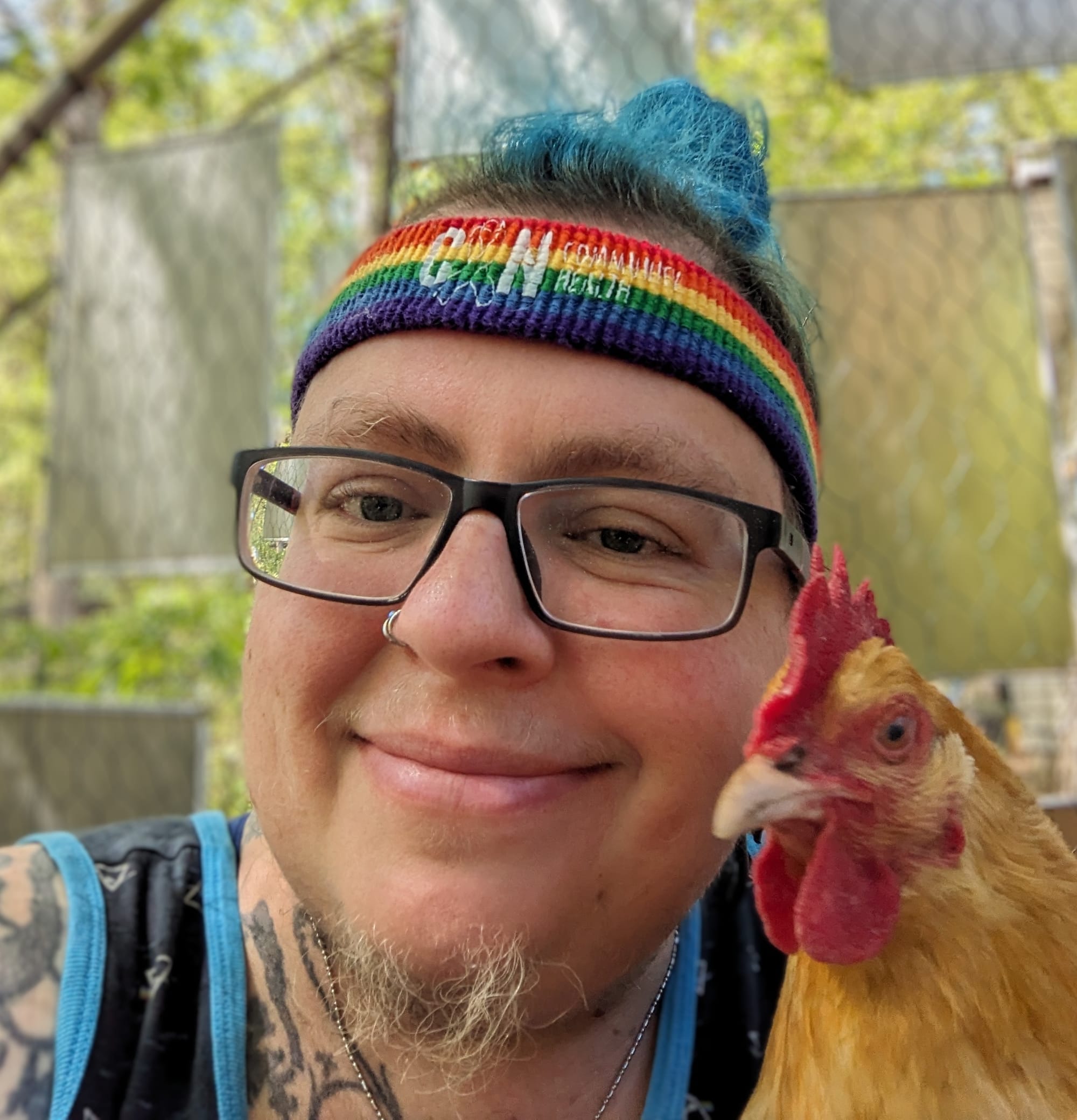
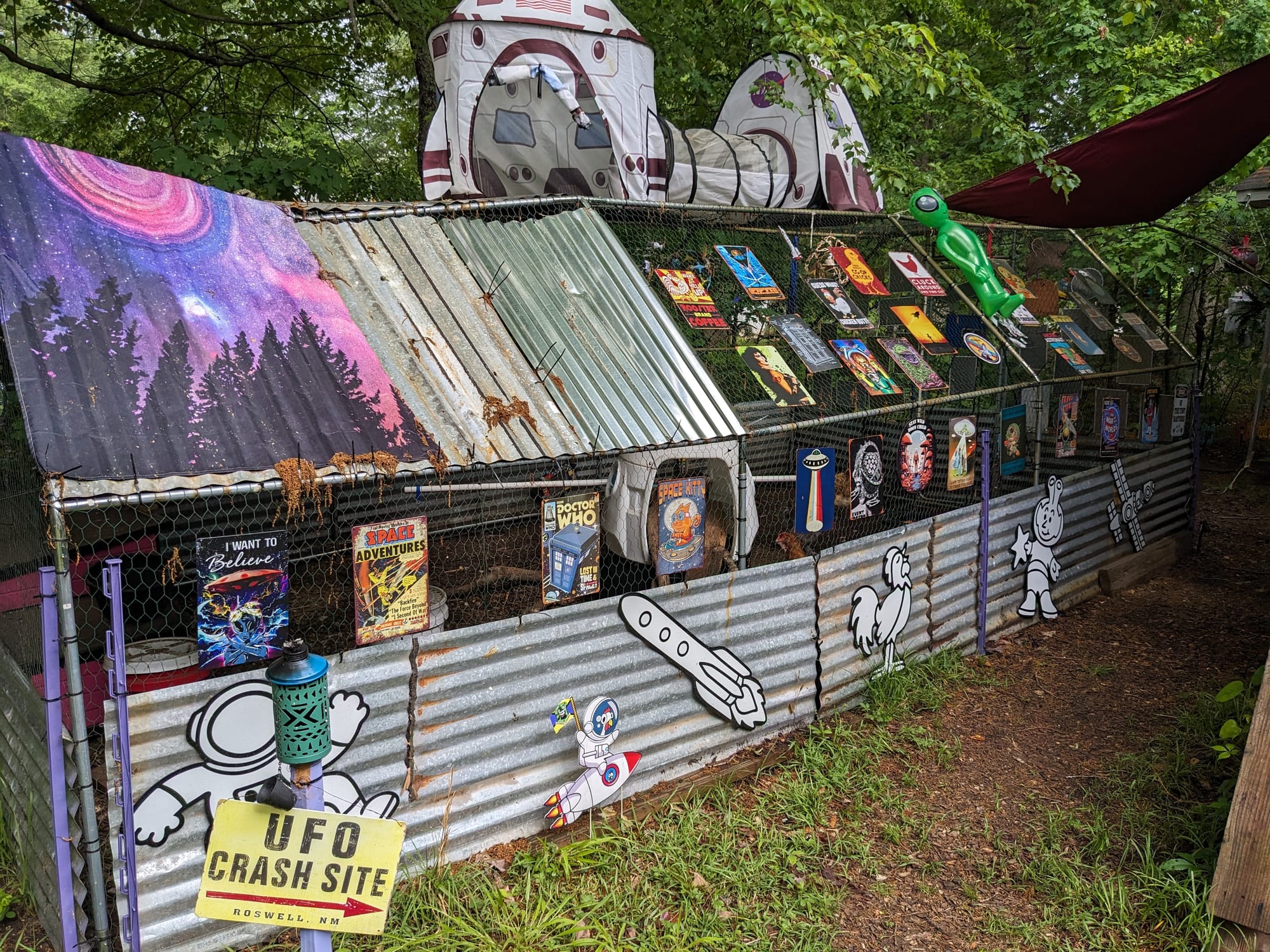
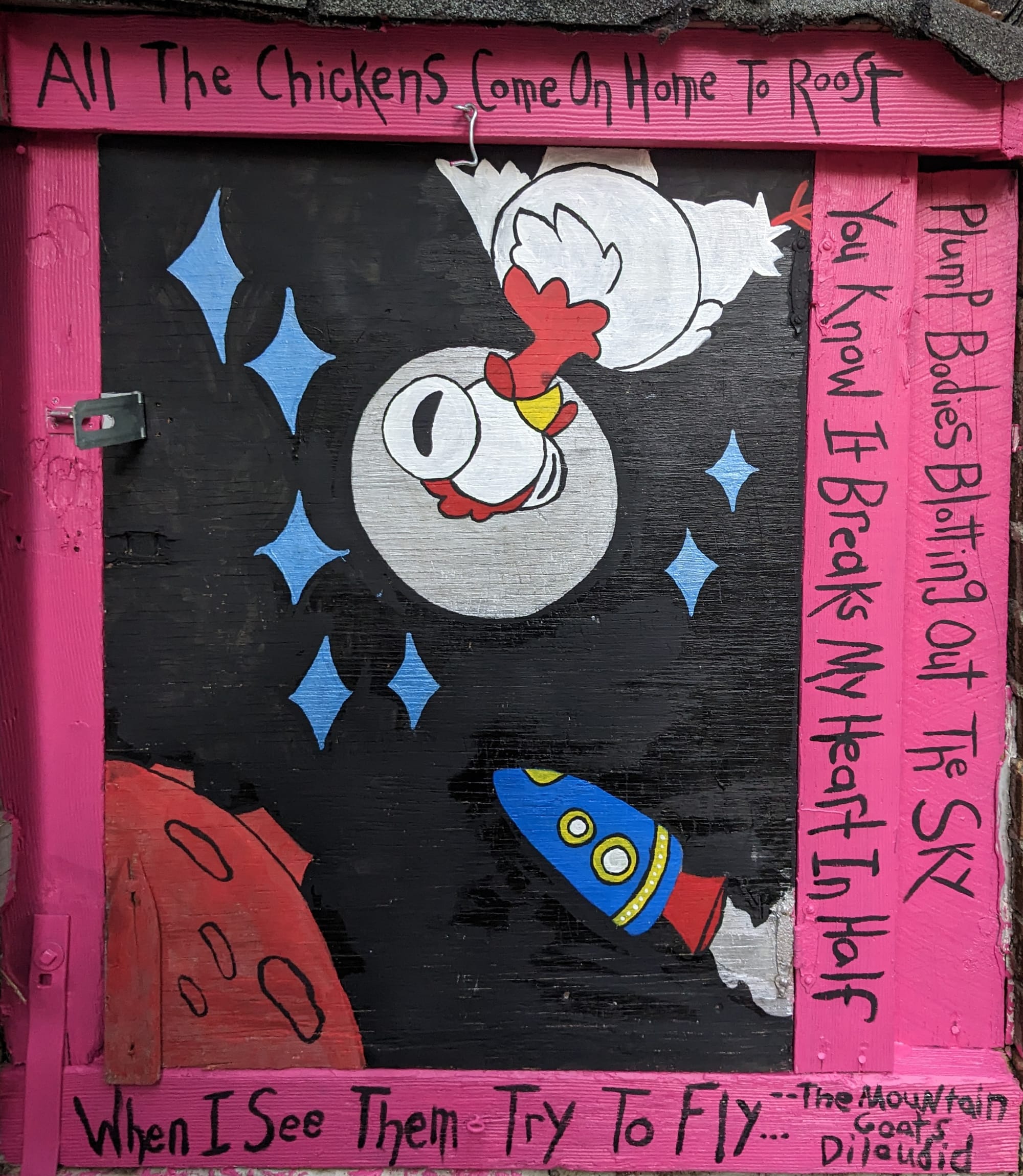
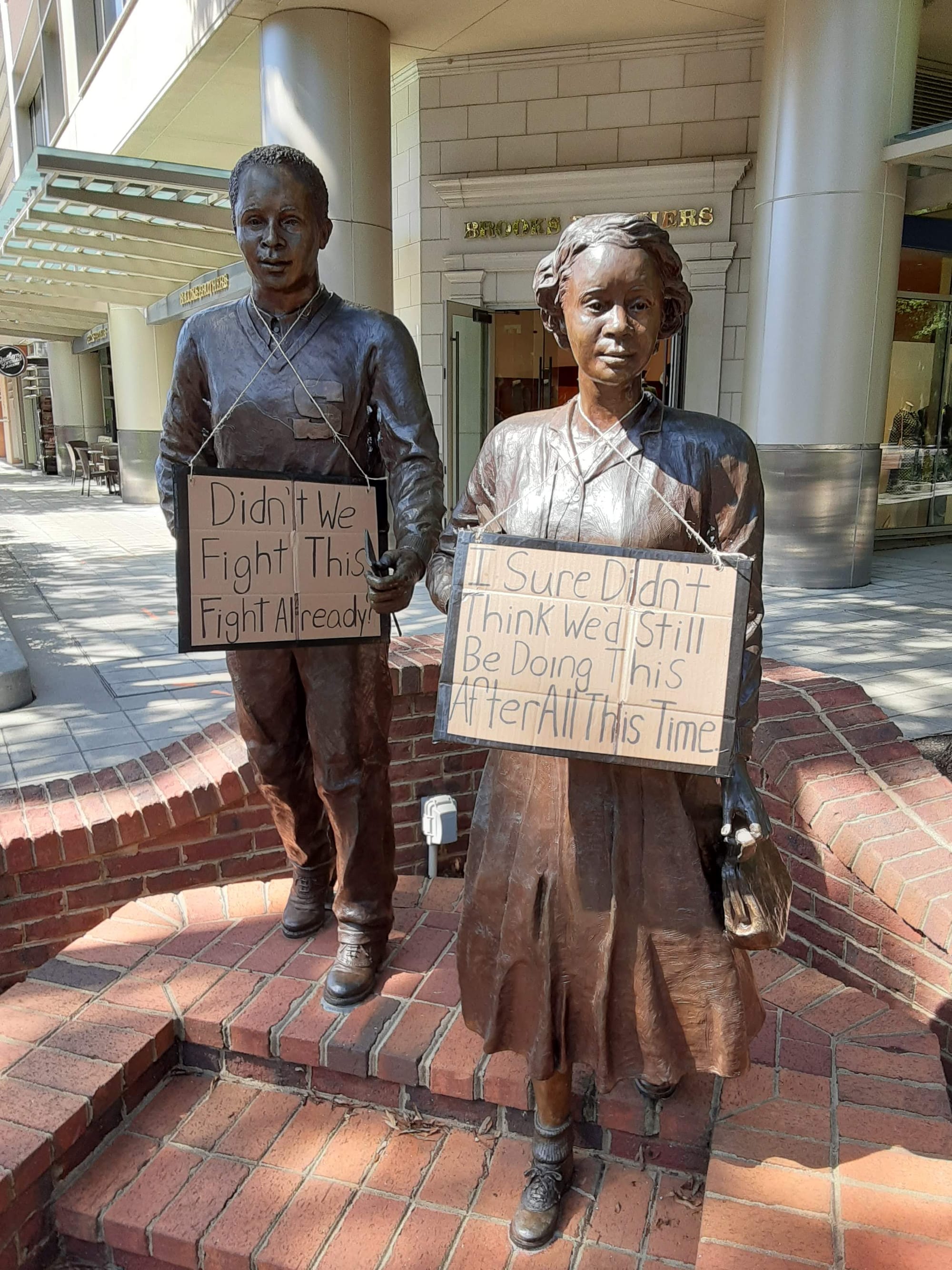
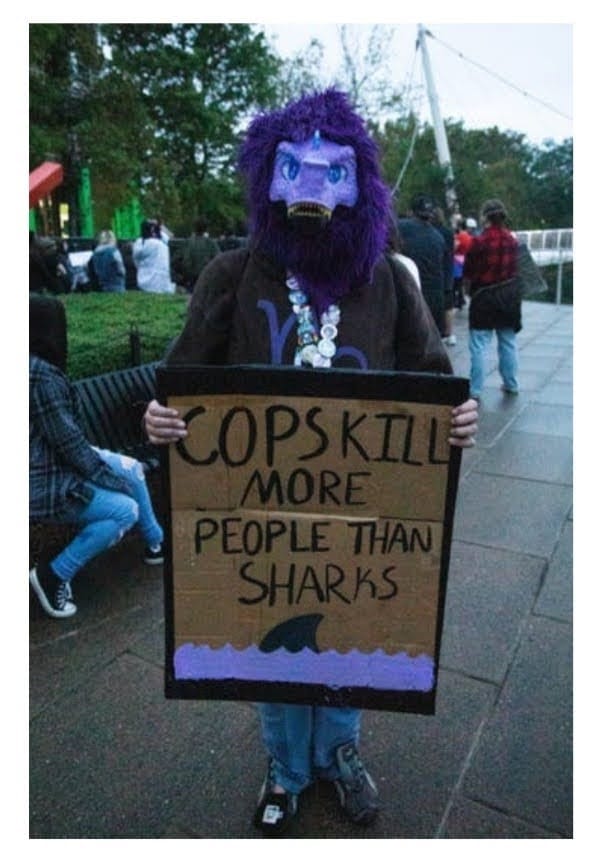
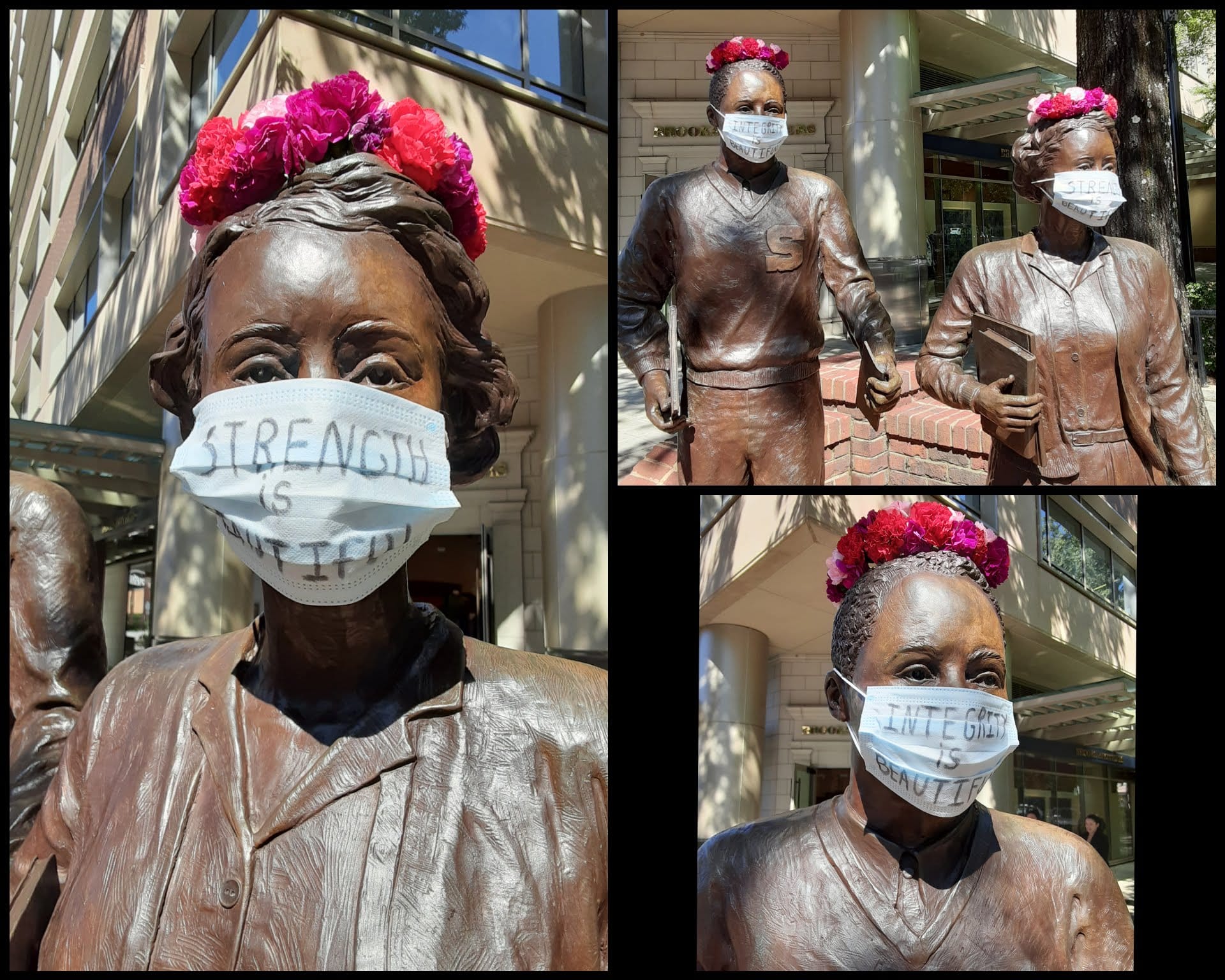
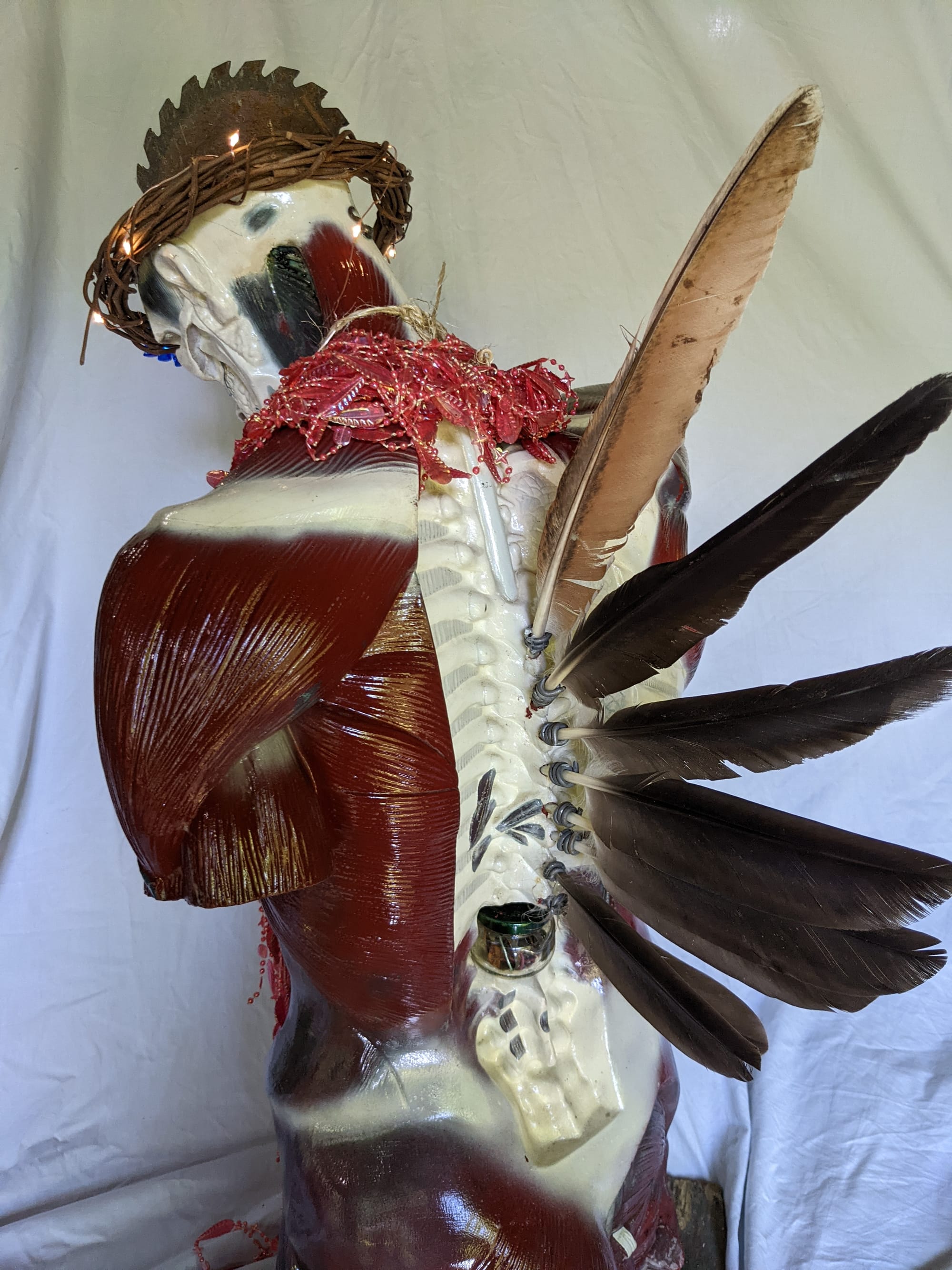
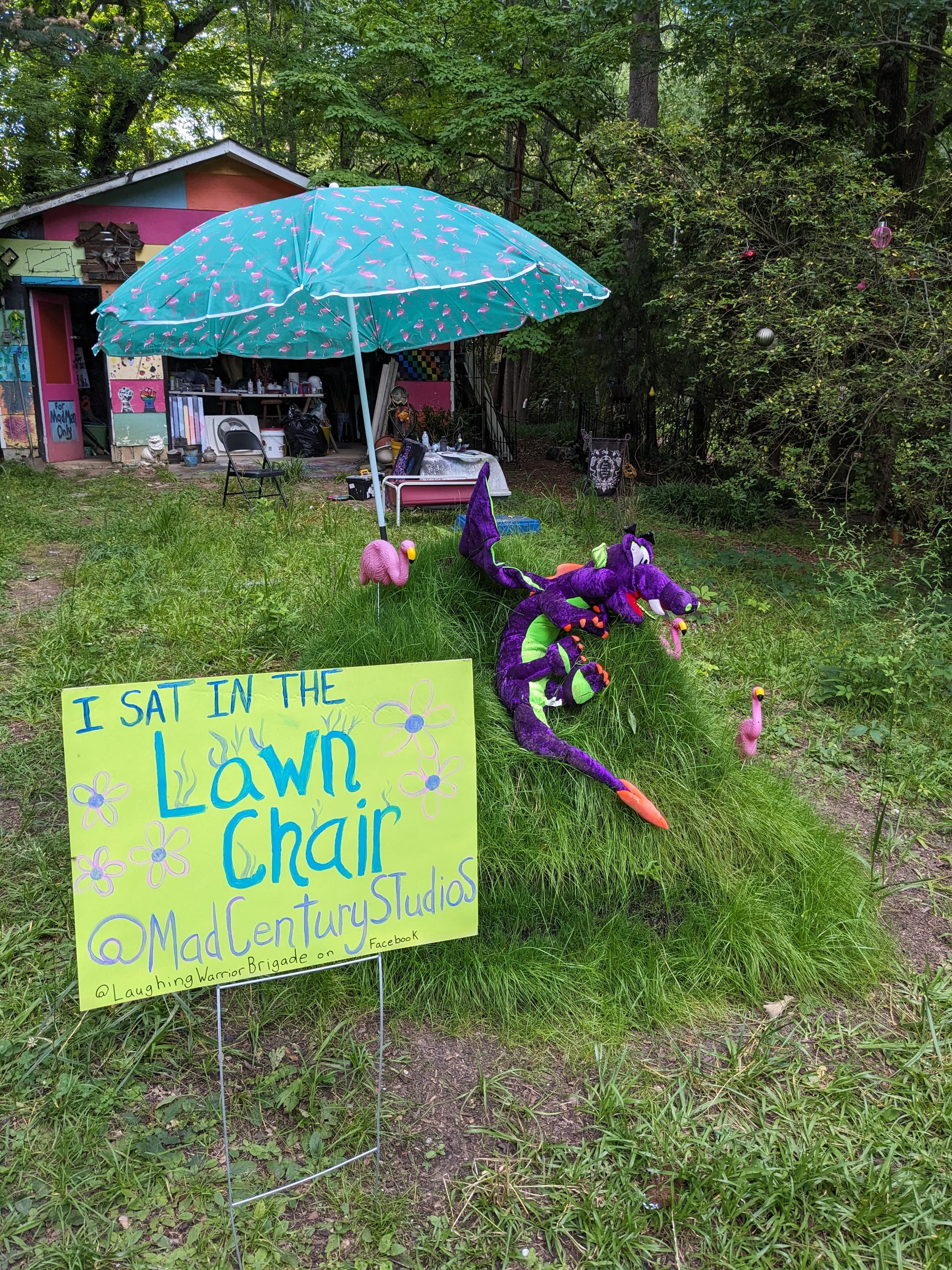
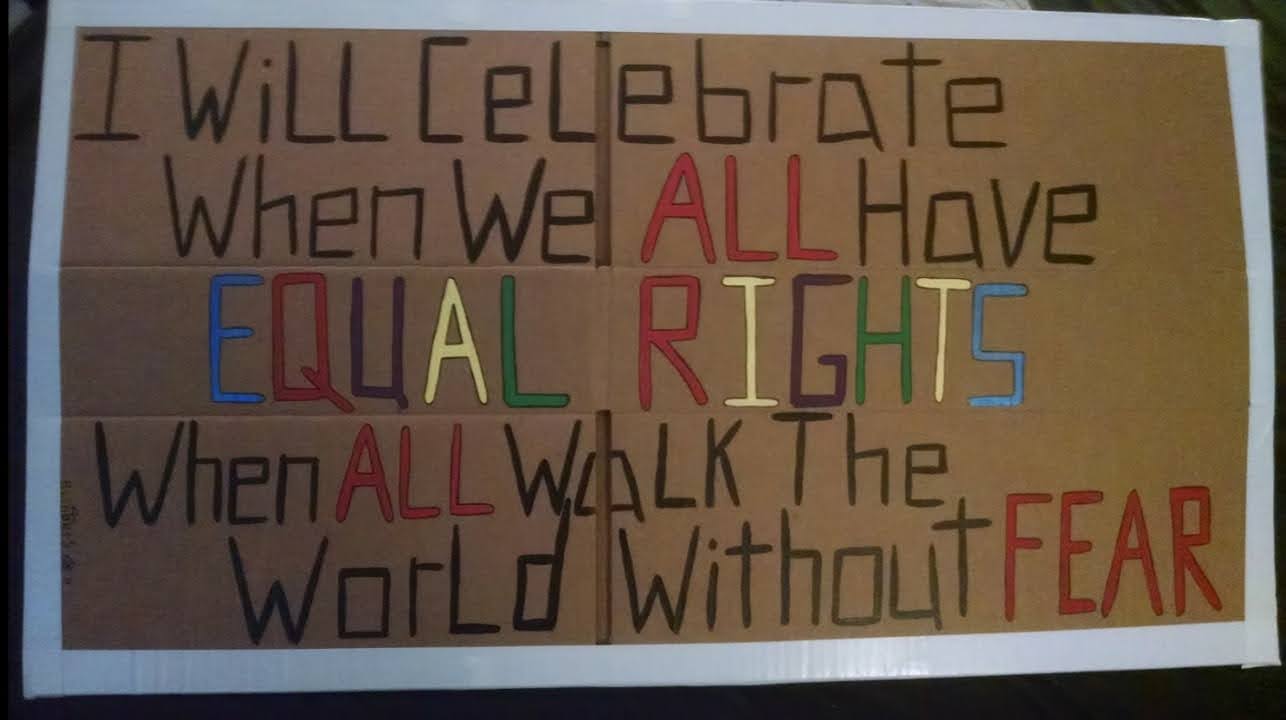
ASH MACNAMARA'S BIO
Ash Macnamara (they/them he/him) of the Clan Dragonghast is one of the Co-founders of the Laughing Warrior Brigade, a non-partisan protest art/performance art troupe and coalition building organization centered in the Upstate of South Carolina on the ancestral land of the Eastern Band of the Cherokee People… All of the core members of the Laughing Warrior Brigade are trans or gender non-conforming though this is not a requirement for membership and they seek to build bridges between communities which are more alike than perhaps they know… The organization also engages in non-violent conflict de-escalation and care for crowds at protests and other public events as well as pop up art installations… Additionally Ash has served periodically on the coordinating committee of the South Carolina Poor People's Campaign as artist in residence and Theomusicolgist in training and also serves the community as a Citizen University Fellow… They have been an ardent activist since they were 13 years and they are involved in a wide variety of social justice issues ranging from Climate Justice to LGBTQ issues to immigration to voting justice, issues surrounding Covid during the pandemic as well as working in partnership with Black Lives Matter during 2020 and beyond…
Ash lives in Taylors, SC with his partner and teenage son in the little house with the grand name, Dragonghast… Their property contains a curiosity museum and public folk art environment, Mad Century Studios and the House of the Improbable, where the public is free to interact with the art, play with the Space Chickens or create art of their own… The Clan Dragonghast shares this amazing space with three lovely cats, the aforementioned Space Chickens, terrariums just full to busting with lizards, toads, salamanders and snails along with a revolving cast of local characters featuring an illustrious family of Palmetto bugs named the Peacocks, a band of possums known collectively as Jacob and a Ghost Cat with dozens of personalities…
FULL TRANSCRIPT
-Introduction
Ame Sanders 00:11
This is the State of Inclusion podcast, where we explore topics at the intersection of equity, inclusion, and community. In each episode, we meet people who are changing their communities for the better, and we discover actions that each of us can take to improve our own communities. I'm Ame Sanders. Welcome.
If you've been a dedicated listener of our State of Inclusion podcast, you know that we believe in the transformative power of art. It's a potent tool that can be used to touch hearts, open minds, and contribute to the creation of a more inclusive and equitable community. Over the years, we've talked with other artists, but this conversation is different. It is about street art, or what I might call guerilla art. Work that lives at the intersection of art and activism. It's about a troupe of artists who engage in activism, support other activists, and use their art to, as they say, "surprise you out of your normal routine."
Before we start, a small aside. Our guests really share their stories with us, so we make the podcast, our newsletter, and related content free as well. However, if you'd like to support us to grow our work, and help to offset some of our production costs, you can find a link to our Support Us page in the show notes. We're happy that you found us. We're grateful that you listen, and we would be thankful for your support.
Today, we are happy to welcome Ash Macnamara. Ash is a community activist and artist and the founding member of the Laughing Warrior Brigade, a performance art, maybe you might call them a protest art troupe, that operates largely in the upstate of South Carolina.
Welcome Ash. Thank you for joining me today.
Ash Macnamara 02:11
Thanks for having me.
-The Laughing Warriors
Ame Sanders 02:12
So, Ash, can you tell us about the Laughing Warriors and what you guys do?
Ash Macnamara 02:20
Well, we have we do a bunch of different things. We're a very tiny organization that generally has between five and nine members at any given point, although we have other people we can call on. Because one of the things we do is make connections in the community between other groups that are maybe larger, more unwieldy, 501(c)(3) kind of groups. We don't have those limitations.
One of the main things that we do is we support protesters, not just protestors, but people at public events...we go to Pride and things like that—just with whatever it takes to keep people able to be out on the streets a little bit longer. So, we give water and food and activities for kids and sunscreen and markers and dog biscuits. Whatever it becomes useful on the street, just so that people are able to be out there expressing themselves longer, more healthily, more safely. We do de facto security. One of our major deals is that we're nonpartisan. We encourage our members to express their personal leanings. It's very much encouraged, but you have to be willing to step across the line and support people on the other side. If you're standing on one side of an issue, and someone on the other side collapses from heatstroke, you have to be the kind of person who's not going to be like, well screw them, let them die in the street. You have to be the kind of person who's like, "Look, we're here because we genuinely believe that this is good for America. That protest is good for America. That free expression is good for America and for the world and for humanity in general."
-Art and Activism
Ame Sanders 04:03
I know that you're also an artist and an activist yourself. In addition to supporting people who are activists and who are demonstrating or protesting, can you talk about the role that you see that playing in stimulating community change?
Ash Macnamara 04:21
Well, I think that the art and the activism, in this case, are almost so intertwined. First of all, I think there's an art to de-escalating people, and I think it takes someone with a sensibility slightly outside the norm to be able to step into a situation like that and be like, "Look, we're here to meet in the middle." So, we do pop up art installations sometimes around town. They're generally designed to appear all at once. We've done things like hanging cardboard signs on statues, which was actually inspired by something called the Luther Blissett Project in France around the early 2000s, which is basically anonymous but for artists. Anyone can be Luther Blisset.
One of the things that they did really famously was use preexisting public art to mount displays that did no damage to the art, like hanging signs around the necks and things like that. So, you have a preexisting focal point that people know exists. It is there. Then, you can draw their attention to a new idea through that same piece of art.
We've done that several times with the statues in downtown Greenville. We had a project where we had signs, and they were all related to the statues, but they gave the statues a new meaning. Then we did one called Life is Beautiful, where we took statues--there were almost 40 statues in that one. We made flower crowns for them and made masks during the pandemic. The masks were themed to the sculpture. So, for instance, a really good example is Shoeless Joe Jackson downtown. We put one in that said, "Redemption is beautiful." And he got a flower crown and a mask. Each one of them was related to the subject in some way.
I think the reason that we like to do things like that, and why I think it's so fundamental to activism is that activism is something that's supposed to surprise you out of your normal routine. If you're just in your normal routine, and you go down the street and you see people chanting on the side of the road, you're gonna stop and think about it for a second. I feel like the art that we make, the way we do it, is designed to give a similar experience to that without being maybe as intense as an actual protest. It just causes you to kind of go, "Whoa. I'm outside of my ordinary for a second. I'm outside of what I expected to see today." That's fundamental to inspiring the spirit of activism.
-Pop-Up and Temporary Art
Ame Sanders 07:00
You talked about your art being these kind of pop up art displays or temporary installations. Why is it that you feel like that is the vehicle that you've chosen?
Ash Macnamara 07:14
So, I'll put it this way. As a parent, I've thought about the things that I want to teach my children, sort of fundamental lessons that I've gotten out of life. One of them that I repeat again and again and again to my son is that change is the only constant. Change is the only thing you can actually depend on in the world, that it will always change. So, I feel like creating transient art gives you this sensation. You get to see that basically. You get to see that more clearly. And also, to be honest, I just really, really love the idea of putting art out there in the world and letting the world do whatever they want with it. They can leave it up. They can take it down. They can mark it up. I like all of that. I think that it again, it takes people outside of their expectations. Also, the fact that we don't charge any money for our art. We just put it out there, and that, I think, also challenges peoples' expectations about what art is for and what it means.
-Art On The Street
Ame Sanders 08:23
I've interviewed some other artists, and one of the things I talked about is that you can reach a lot more people when you get art in the streets, out to the street.
Ash Macnamara 08:33
Absolutely. I mean, we had not done a whole lot of that until--really, we formed early in the pandemic just by basically seeing needs that were out there on the street. But in addition, when the pandemic first started, we actually kind of thought we'd be out of business. Because we were like no one's gonna gather in big groups. So, we're at least out of business until this is over.
We were so wrong. But early in that, when I thought we were going to be out of business and still wanted to do something, we created a series of COVID-related posters on cardboard really quickly. They're beautiful. They're really stark and beautiful, but they're designed to be done extremely quickly and put out there. It was because there were messages that I felt needed to be out there in a format that maybe people could digest just a little easier. Also, really, with that one, we wanted people to know that there were people who were trying to keep things together. The core felt so frayed at that time in history that we wanted people to be able to see it publicly. They had messages like "Live like you want to survive" and "Masks save lives" and stuff like that. But also, you know, things like "Rest in Profits" and "Liberate the scientists" and stuff like that. We wanted people to know that there were still people caring about stuff like that and thinking about stuff like that, and acting on stuff like that, even when we were so isolated.
-A Word About Activism
Ame Sanders 10:03
I want to circle back to the activist part of your work and your sensibility. When we were together, you talked about the role of activism in community and societal change. I just wonder if you could share a little bit of your perspective on that.
Ash Macnamara 10:18
Sure. I've thought a lot about this because I believe to be a good activist, you have to study the history of how that's all gone down. I feel like activism is the sort of unwritten fourth branch of the US government. I am uncertain from a historical perspective why the founders didn't think to put it in, maybe because their culture was so activist. The revolution itself was like an activist movement. They didn't think that would ever need to be codified. But when you think back on every massive societal change that's managed to happen that people have made happen in American history: freedom for slaves, and votes for black people, and votes for women, and prohibition, and then, the repeal of prohibition.
All of these things had huge social movements behind them that were made up of ordinary human beings coming together to say, "No. This is what we want society to look like." Because it's not codified in the Constitution, people don't necessarily see it that way. But it's ignoring history to not realize that nothing gets done around here unless people stand up and say, "Look, something needs to be done."
-A Roadside Attraction and Gallery
Ame Sanders 11:39
I love that philosophy in that perspective. So along with that, if we bring these two things back together, your art and your activism, and the work that you do with the Laughing Warriors, one of the things on a lighter note, I would say is I visited your place and your studio. You have kind of an unusual gallery, I would say, at home. Tell us about why you created it and what role you want it to serve in your work.
Ash Macnamara 12:06
Yeah, we run basically a roadside attraction. I think it goes right along with what I'm saying about the world being full of unexpected things and my wanting to bring attention to that. We're in a residential neighborhood. We're just in my backyard. We have a fully themed chicken coop that's all space-themed, and the chickens will hang out with you. We run an oddities museum. Again, I think it's the same thing. I just want it to feel like, "Wow. I never would have expected such a thing just in this normal little neighborhood." It takes people outside of themselves.
Also, in our oddities museum, we present gaffed oddities, like made oddities, right alongside real historical items because I think it's important that people learn to distinguish those things themselves. I think people need to be able to look and "Okay, so that's a piece of beautiful bone music, music on X-rays from Russia. It's clearly real. That says, 'Petrified Dragon Claw.' That's probably not real." We want people to literally be engaging their minds like that. That's why we present them together like that. Also, it just gives us a really great chance--all of our grounds are a natural meadow like a pollinator meadow. So, when people come in, we can talk to them about like, "Look. We have so many bugs and birds and fungus and all kinds of fun stuff on our property." And we can show people it's an easy thing you can do to help the Earth and to help the pollinators. Things like that. It just creates conversations and, like I said, takes people outside of their expectations.
Ame Sanders 13:50
One of the ones I loved was your lawn chair.
Ash Macnamara 13:56
The lawn chair looks so much better than when you were here to just a couple of weeks ago. The lawn chair took an entire year to do, and I often say that if I knew that it was going to deplete Greenville strategic dirt and grass feed reserves, I never would have started. It was so much, so much dirt.
Ame Sanders 14:15
Can you describe it for our listeners?
Ash Macnamara 14:17
It's a chair, a full-sized throne made out of living grass. It was built with a superstructure of cinder blocks, but everything over that was built in dirt. Then the seeds were like meticulously pressed in over months and months and months. It's just now at the point where we're starting to have people actually sit in it. But that was the thing. When you came here wasn't quite ready. It was still a little scrappy.
Ame Sanders
A little muddy.
Ash Macnamara
Yeah, it looks amazing now, and it's got some pink flamingos on it and a little lawn umbrella over it. It's a fun spot. See again, it's about going outside of your expectations. I sat in it for the first time yesterday, and it was the weirdest experience. It feels very interesting and strange to be sitting on that grass and to have it kind of all around you. So yeah, it's a piece I'm very happy with. And again, it took a whole year.
Ame Sanders 15:17
So, we've talked about different aspects of your art. So, some of it is temporary and pop-up and sort of guerrilla art. Then some of it is very physical and stationary like the lawn chair, which took a long time to build and grow. But then some of it is also very personal and raw and real. So, it's it's not all whimsy or light either. You have pieces in your gallery that are deeply personal.
Ash Macnamara 15:49
Yeah. I'm thinking specifically of Nigel Awake, which is made out of an antique anatomical dummy that I had for many years, just literally kicking around my house in the corner of my house. We named him Nigel, and he was our buddy. Then, finally, years in, I was able to create this piece. It's about my tension as a man who has given birth to children. It's about the idea of gender and it being a thing that grows and changes over time. And also, it's a little bit about my sons because I do preserve dead animals as part of my art. In the sort of womb area of Nigel is a vessel that has two baby chicks.
I have two sons, who are also trans, and have mental illness and things like that. And it reflects how I feel like I'm unable to give them a life of thriving. That like all my efforts, all my arts, all my power, it can only go to just holding them in place and not like lifting them up. Not giving them light. So it is. It is possibly the most deeply personal piece in there. It is all about like my relationship to myself and my sons. I use the preserved dead animals in some of my work. I mean, I made a hobby into, I guess, a career of doing that because I'd lost a lot of friends. It felt like the ability to physically hold back decay, to physically hold back entropy was valuable to me psychologically.
-Advice for Activists, Artists, and Instigators
Ame Sanders 17:32
Wow. So, I think that gives people a sense of the range of some of the work that you do and how you think about your art both personally and also from a societal standpoint, which is really insightful. Let's say we have activists and artists listening in today. What advice would you give them? Or what advice would you give to people who aren't activists or artists but who believe, like I do, that we need more of both of those things in our community? So, what advice would you give to the activists and artists and maybe the dreamers and instigators in all of us?
Ash Macnamara 18:15
Well, yeah, I think I would say they're the same thing. There's too much societal limitation and self-limitation. Gatekeeping, that's what I'm talking about. There shouldn't be gatekeeping on what makes you an artist, or what makes you an activist, or what makes you anything that you feel like you are. If you think that you are that, then you are. You get to define who you are. As far as actually acting on it, that is something that I truly, truly believe you can do all by yourself in your home if that's all that you're capable of, able to do, or willing to do. All the way up to, you can go and find community. We're out there if you just search for the various different causes that you care about.
Because that's another thing that I try to tell my son because he's been an avid activist since he was a child, you're going to care about a lot of things. Find the things you care about the most. Pick a few that you care about the most and focus on those. Do what you can for the other things that you care about. But if you try to solve the entire world all by yourself, you'll break down. There's no doing that. That's a sure way to burnout. But if you pick the things, you know, there are two issues that you're just super passionate about, just start searching on Facebook and Instagram and things like that. You know, the ordinary ways people get in touch and find community. Or, literally, just do it. You want to make a piece of art and stick it on your lawn or on the corner of the street or whatever? You should just do that. I know it's not as easy as that for everyone. But also, I think there is a freedom in anonymous street art that allows you to say things that you couldn't say necessarily to someone's face.
Ame Sanders 20:16
That is probably a good place for us to wrap up. Ash, thank you so much for joining us today. We really appreciate the conversation, and I really appreciate your work as well.
Ash Macnamara 20:36
Thank you so much. It was a real pleasure to be here.
-Close and Recap
Ame Sanders 20:32
In this episode, Ash shared a lot of wisdom with us. This interview was shorter than many, so you don't need a long summary. I just want to leave you with a few of their pearls of wisdom. We heard how art and activism can be intertwined because they share the same spirit. How powerful it can be to use the freedom of anonymous street art to stimulate change. And that art can serve as a tool to reach people– surprise them out of their norm—and, in that fleeting moment of surprise and openness, present a new and unexpected idea.
One approach we talked about was leveraging pre-existing public art as a focal point and a canvas to disrupt or engage. Doing it in a way that's non-destructive, of course, and temporary. That's not a new idea. But it's one worth thinking about. I love the discussion about the perspective that activism is the sort of unwritten fourth branch of the US government and has always been a part of any substantive change or progress.
Then, finally, Ash reminded us of something that is relevant for all of us and perhaps our thought of the day. Pick just a few things you care about the most. Focus on them.
This has been the State of Inclusion podcast. If you enjoyed this episode, the best compliment for our work is your willingness to share the podcast or discuss these ideas with others. If you'd like to hear more about the practice of building an inclusive and equitable community, head over to theinclusivecommunity.com and sign up for our newsletter. Also, feel free to leave us a review or reach out we'd love to hear from you. Thanks so much for listening, and join us again next time.
CONTRIBUTORS
Guest: Ash Macnamara
Host: Ame Sanders
Social Media and Marketing Coordinator: Kayla Nelson
Podcast Coordinator: Emma Winiski
Sound: FAROUT Media


